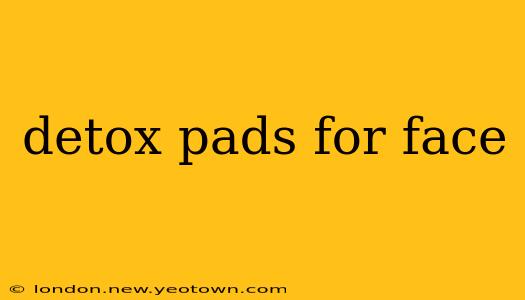The beauty aisle is a wonderland of promises, and lately, detox pads have taken center stage. But do these convenient little discs truly deliver on their claims of purifying and revitalizing your skin? Let's dive into the world of facial detox pads, separating fact from fiction and uncovering the science (or lack thereof) behind their popularity.
My journey into the world of detox pads began with a simple question: Do detox pads actually remove toxins from my skin? My initial research revealed a fascinating blend of marketing hype and legitimate skincare ingredients. The truth, as it often does, lies somewhere in between.
Do Detox Pads Actually Remove Toxins from My Skin?
This is the million-dollar question. While the term "detox" is often used loosely in the beauty industry, the skin's natural processes already handle toxin removal. Your skin, in fact, is quite adept at this. Sweat glands, sebaceous glands, and the skin barrier all work tirelessly to eliminate impurities. Detox pads don't magically pull toxins out; they might assist in removing surface-level dirt, oil, and makeup residue.
What are the Benefits of Using Detox Pads?
While they might not perform a deep-tissue detox, detox pads can offer several skincare benefits. These benefits often come from the ingredients included in the pads themselves, not from some mystical toxin-removal process.
Convenient Exfoliation:
Many detox pads contain ingredients like AHAs (alpha-hydroxy acids) or BHAs (beta-hydroxy acids), which gently exfoliate the skin. This exfoliation can help remove dead skin cells, leading to a brighter, smoother complexion. Think of it as a quick and easy way to polish your skin.
Improved Skin Texture:
The exfoliating action of certain detox pads can help improve the overall texture of your skin, making it feel softer and smoother. However, remember that over-exfoliation can cause irritation and damage, so moderation is key.
Targeted Treatment:
Some detox pads are formulated with specific ingredients to address particular skin concerns, like acne, redness, or uneven skin tone. These ingredients might include tea tree oil for acne, calming chamomile extract for redness, or brightening vitamin C for uneven tone. Always carefully read the label to understand the specific ingredients and their intended purpose.
What are the Potential Side Effects of Using Detox Pads?
Like any skincare product, detox pads can have potential side effects, particularly if misused or if you have sensitive skin.
Irritation and Redness:
Over-exfoliation or the use of harsh ingredients can lead to irritation, redness, and inflammation. Always start slowly, using detox pads only a few times a week, and observe your skin's reaction.
Allergic Reactions:
Some individuals may be allergic to certain ingredients found in detox pads. Always perform a patch test before applying the product to your entire face.
Dryness:
Exfoliating pads, especially those with AHAs or BHAs, can be drying. It's crucial to use a moisturizer after applying detox pads, especially if you have dry skin.
What are the Ingredients to Look for (and Avoid)?
Choosing the right detox pads involves understanding their ingredient list.
Look for: AHAs (glycolic acid, lactic acid), BHAs (salicylic acid), hydrating ingredients like hyaluronic acid, and antioxidants like vitamin C or green tea extract.
Avoid: Fragrances, harsh sulfates, and alcohol, as these can further dry out or irritate your skin.
Are Detox Pads Right for Me?
The answer to this question depends on your individual skin type and concerns. If you have oily or acne-prone skin and are looking for a convenient way to exfoliate, detox pads might be a beneficial addition to your skincare routine. However, if you have sensitive or dry skin, you might want to proceed with caution or choose a gentler alternative.
Ultimately, detox pads are a tool, and like any tool, their effectiveness depends on how you use them. Remember that healthy skin starts with a balanced approach, including a nourishing diet, sufficient sleep, and a consistent skincare routine. Detox pads can be a part of that routine, but they are not a magic bullet. They complement, they don't replace a holistic skincare approach.

